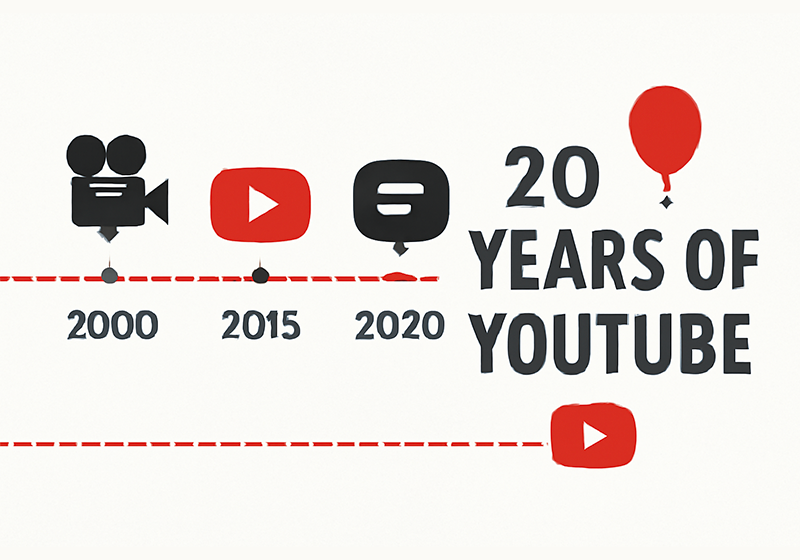Table of Contents
An intuitive website where anyone can upload a video for anyone to watch anywhere on Earth. We take it for granted today, but in the early noughties, before YouTube came along, there was no such thing.
When it launched in 2005, YouTube’s unique appeal was to let users watch videos online instantly without having to sign up or download anything. It soon grew into a giant video archive for humanity, a place to teach and to learn, to entertain and be entertained. And much more.
To mark the platform’s 20th anniversary, today we tell the story of YouTube – and reveal how it has become an invaluable tool for graphic design professionals.
Once upon a time there was a dating site…

The first incarnation of YouTube was born on 14 February 2005, when the domain www.youtube.com was registered. The date – Valentine’s Day – was no coincidence. The three founders – ex-PayPal employees Steve Chen, Chad Hurley and Jawed Karim – initially created an online dating site where users would upload videos introducing themselves. A precursor to Tinder, basically. The slogan was “Tune In, Hook Up”. But few people did.

But online dating wasn’t the only inspiration for YouTube. Another was the founders’ difficulty in finding footage online of two very different events that occurred in 2004: the tsunami that devastated coastlines in the Indian Ocean and the infamous wardrobe malfunction in the Superbowl show performed by Janet Jackson and Justin Timberlake.
Whatever the actual story behind YouTube, we at least know what was the first video uploaded to the platform. On 23 April 2005, Jawed Karim posted Me at the zoo. This endearingly simple video perfectly encapsulates what would make YouTube so successful: immediacy and accessibility.
YouTube would let anyone, anywhere have their 15 minutes of fame!
The YouTube boom: from Ronaldinho to Gangnam Style
In its first year of business, YouTube changed its slogan to “Your digital repository”. And in just a few months, the beta version had racked up millions of videos and views. An ad for Nike starring Brazilian footballer Ronaldinho was the first video to reach a million views – and that was even before YouTube’s official launch in December 2005, by which point the site already boasted millions of daily viewers.

But success brought spiralling costs. YouTube needed ever more powerful servers (despite videos being limited to 30 seconds in 2005). And it also had to put cash aside to fight lawsuits, because many videos uploaded to YouTube infringed copyright.
YouTube was put up for sale and was snapped up in 2006 by a dream buyer, Google, who paid $1.65 billion. The platform’s slogan changed to “Broadcast Yourself!”, and a new sociological phenomenon emerged: the YouTuber.
Generation tutorial: YouTube as a font of knowledge
One of the best and healthiest uses of YouTube is spreading knowledge. Millions around the world share reviews and tutorials on anything and everything. Behind the scenes, Google’s algorithms learn what we like and suggest similar content for us to watch, keeping us glued to the platform.

Despite being one of the “oldest” social networks out there, YouTube remains a media powerhouse. With 2.4 billion monthly users, it is second only to Facebook in popularity. And YouTube holds its own against streaming platforms like Netflix and traditional broadcasters like the BBC. It’s also a place to listen to music, boasting more plays than Spotify.
But above all else, YouTube remains a giant repository of knowledge.
Who hasn’t typed the words “how to…” into its search bar?
YouTube: the go-to resource for graphic design and printing
The average American YouTube user spends almost 50 minutes a day on the platform. And much of this time is devoted to learning something new. Take a subject close to our heart, graphic design. YouTube offers a bewildering array of resources for mastering the skills and tools of the trade.

For example, there’s Yes I’m a Designer, a channel where certified Adobe instructor Martin Perhiniak dispenses tips and tutorials on how to use Adobe tools, including Photoshop, Illustrator and InDesign. Another influential YouTuber, with almost a million followers, is Will Paterson, who explores logo design and hand lettering.
Then there’s Charli Marie, a veteran YouTuber who serves up a mix of design tutorials and insights into the working life of a graphic designer and creative director. Covering the business and marketing side, including managing clients, quoting and personal branding is The Futur, a channel with over 2 million subscribers. And, finally, we have Linus Boman’s channel dedicated to curious stories and trivia about design.

Also worth checking out are channels providing inspiration for DIY interior decoration like Lone Fox, printing techniques like Catspit and MyloPrints, woodcarving like Linker and typography like Type Directors Club. This last, more institutional channel contains hundreds of ours of talks and conferences about type design. And if that’s not enough for type obsessives, there are even type designers who livestream themselves at work!
There you have it: in the space of two decades, YouTube has become an indispensable resource for training and entertaining generations of designers.
How do you use YouTube? Do you love tutorials, too? Is the platform your go-to for learning?

